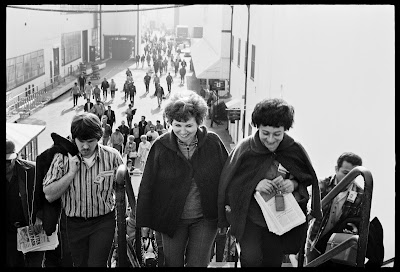Louis Kahn: The Power of Architecture
The San Diego Museum of Art
On view through January 31st
Article by Cathy Breslaw
 |
| Salk Institute, La Jolla, California Designed by Louis Kahn buildings completed 1963 |
Kahn’s personal life was complicated – he was married once but had two additional major relationships where each bore one child. His youngest child and only son Nathaniel Kahn, is a film-maker who created a documentary tracing his father’s life. In search of his own identity after losing his father at age eleven, the spirit of the film about his father’s life is present throughout the exhibition. The extensive and detailed timeline of Louis Kahn’s life is displayed at the entrance to the exhibition, providing viewers with a ‘map’ of the following rooms which focus on various time periods of Kahn’s architectural pursuits and buildings he created.
While simultaneously creating building plans and pursuing his
architecture career, Kahn was also professor of architecture at the University of
Pennsylvania for many years. He urged his students to “honor the materials you use, to glorify, not short change it”. A residency in 1951 in Rome Italy greatly
influenced Kahn’s work as he pursued the creation of buildings that have the
feel and presence of ancient ruins while also possessing a timelessness and
monumentality. The influences of Roman architecture can be seen in his wooden
models of buildings displayed as well as metal structural forms that evidence
some of his ideas.
Kahn’s major accomplishments are the Salk Institute in La Jolla,
California, the Richards Medical Research Labs in Philadelphia, Kimbell Art
Museum in Ft Worth Texas, Philips Exeter Academy Library in New Hampshire, Yale
University Art Gallery and the Yale Center for British Art (both on the campus
of Yale University in New Haven, Connecticut), and the National Assembly
building in Dhaka, Bangladesh completed in 1983 after his death. It is interesting to note that the building
in Bangladesh took 23 years to build and was built almost entirely by hand.
Aside from these important buildings, there were many buildings that
remain unrealized and the architectural models for these are displayed
throughout the exhibition. Kahn also created a limited number of private
residences whose photos, plans and models are also included in the show. There are also a number of preliminary
drawings and sketches of Kahn’s ideas about various building structures
presented. Also included are a group of oil and watercolor paintings that Kahn
created throughout his life which are on loan from the personal collection of
family members.
Interspersed with photos, paintings, drawings, wooden architectural
models and lots of textual explanations of Kahn’s work, are video short
interviews with important architects influenced by Kahn’s work, video film of Kahn
speaking in various locales and other details of his work life. Architect Frank
Gehry commented that his own first works came out of a reverence for Louis
Kahn.
In honor of Kahn's buildings at the Salk Institute in La Jolla California, the students at the Woodbury University School of Architecture exhibit a series of photographs of these buildings. The photos allow viewers to see the buildings through the eyes of 'future' architects and highlight the materials, the spaces and geometries of the outdoor building spaces.
From a man whose family immigrated to the United States from a small
island off the coast of Estonia to Philadelphia in 1903, Kahn went on to captivate the world with his
buildings that he hoped would influence and improve peoples’ lives. His
buildings are described as possessing symmetry, order, geometric clarity and
enormous weight. Separating himself from
other architects of his time, Kahn wanted to elevate architecture from utilitarian
forms to meaningful spaces with inspirational and transcendent qualities.
 |
| Designed by Louis Kahn National Assembly Building Dhaka Bangladesh 1960-1983 |
 |
| Designed by Louis Kahn National Assembly Building Dhaka Bangladesh 1960-1983 |
 |
| Designed by Louis Kahn Kimbell Art Museum Ft Worth Texas 1972 |
 |
| Designed by Louis Kahn Kimbell Art Museum Ft. Worth Texas 1972 |





